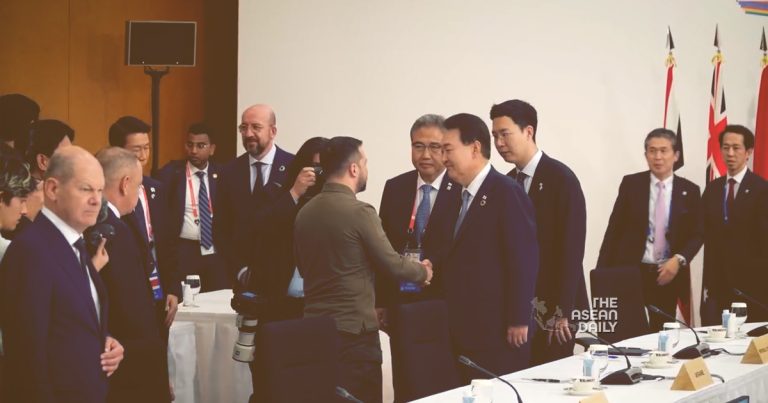22-5-2023 (HIROSHIMA) Ukrainian President Volodymyr Zelenskyy concluded a successful diplomatic mission in Hiroshima on Sunday (May 21), returning home with new weapons, ammunition, and unwavering diplomatic backing from G7 allies. Utilizing the powerful symbolism of Hiroshima, synonymous with the horrors of war, Zelenskyy urged partners and skeptics to support Ukraine’s defense against Russia’s ongoing aggression.
The need for this bold diplomatic move in Japan was underscored by setbacks on Ukrainian soil, where Russia claimed to have gained control over the eastern city of Bakhmut after months of devastating conflict. Nevertheless, Zelenskyy can claim victories on multiple fronts, having secured US support for the provision of advanced fighter jets and the opportunity to engage influential non-aligned nations like India, who have refrained from condemning Russia’s invasion.
Zelenskyy skillfully employed the emotional history of Hiroshima to emphasize the despair caused by the destruction of his country, particularly in Bakhmut, a front-line city now allegedly under Russian control. Reflecting on his visit to the city’s museum, which vividly portrays the suffering inflicted by the 1945 US nuclear bombing, Zelenskyy remarked, “The photos of Hiroshima remind me of Bakhmut. Absolute total destruction. There is nothing. There are no people.” However, he remained resolute in Ukraine’s commitment to rebuild, joining Japanese Prime Minister Fumio Kishida in a solemn ceremony to lay flowers at a cenotaph honoring the 140,000 victims of the atomic bomb.
While Zelenskyy denied the occupation of Bakhmut by Russian troops, he acknowledged their presence in the city, which has been reduced to ruins through relentless and unyielding warfare. Nonetheless, as he departed Japan, Zelenskyy received reassurances that his allies would stand firm in the fight, with US President Joe Biden asserting that Ukraine’s supporters “will not waver.” Biden stated, “Putin will not break our resolve as he thought he could,” following his meeting with Zelenskyy. The White House also unveiled a substantial aid package of US$375 million, comprising ammunition for HIMARS rocket launchers, artillery shells, anti-tank guided missiles, and thermal imaging systems.
In addition to the pledged supplies, the trip proved to be a significant diplomatic triumph for Zelenskyy. In response, Moscow condemned the entire G7 summit as a “propaganda show,” generating “hateful anti-Russian and also anti-Chinese messages.” Concurrently, the Chinese Foreign Ministry summoned Japan’s ambassador to express their protest against what they perceived as efforts to “smear and attack” China during the gathering.
Zelenskyy effectively placed his country’s plight and Russia’s invasion at the forefront of the summit’s agenda, securing firm support for crucial aspects of his ten-point peace plan, with a primary focus on the necessity of a Russian withdrawal. German Chancellor Olaf Scholz conveyed the clear message from Ukraine and its allies: “Russia must withdraw troops.” He emphasized that any peace plan should not be contingent on a mere freeze of the conflict, warning Russia against the belief that prolonged endurance would weaken support for Ukraine.
Moreover, the summit offered Zelenskyy a rare opportunity to present his case to several nations that have remained conspicuously silent or provided minimal condemnation of Russia’s incursion. Leaders from India, Brazil, Vietnam, and Indonesia were among those invited to attend the summit as non-members. Following a one-on-one meeting, Indian Prime Minister Narendra Modi assured Zelenskyy, saying, “I understand your pain and the pain of Ukrainian citizens very well. I can assure you that India, both as a nation and myself personally, will do whatever we can to resolve this.”




